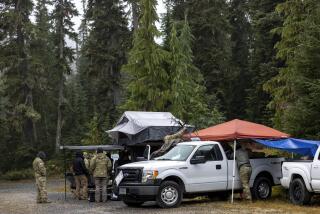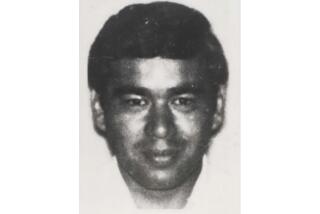Airman killed in 1942 crash is identified
The remains of an airman killed in a 1942 military training crash have been identified nearly a year after they were found in the Sierra Nevada by an author researching the accident.
Defense Department officials announced Monday that they had identified Aviation Cadet Ernest G. Munn of St. Clairsville, Ohio, one of four crew members who died.
Another airman, Leo A. Mustonen of Brainerd, Minn., was identified in 2006 after hikers the previous year discovered his remains partially encased in a glacier near the crash site in Sequoia and Kings Canyon National Park.
This week’s announcement came after DNA analysis by scientists working for the Defense Department’s Hawaii-based Joint POW/MIA Accounting Command.
The identification ended a tense wait for Munn’s family.
“We’re happy he’s been recovered,” said nephew Scott Shriver, a high school teacher in Pittsburgh. “But it does dredge up old, unhappy memories. It’s been tough on his sisters.”
Munn’s three sisters, now in their 80s, plan a May funeral in Pleasant Grove, Ohio, for the brother who disappeared when he was 23. Munn, who was a sharp dresser and classically handsome, aimed for a career in finance before joining the Army Air Corps.
His plane vanished after taking off from Mather Field near Sacramento on Nov. 18, 1942. Five years passed before a hiker found its widely scattered wreckage and some remains that at the time were unidentifiable. They were buried in a common grave, topped with a marker denoting all four crew members, at a Veterans Administration cemetery in San Bruno, Calif.
After Mustonen was identified, the marker was replaced with one that had just three names.
Intrigued by the crash and the subsequent discoveries, Seattle author Peter Stekel set out to trace the airmen’s journey, and last summer searched for debris on Mt. Mendel’s Darwin Glacier. Near the site of the 2005 discovery, he and a partner found part of an engine that may have been exposed by melting ice.
Then Stekel, an experienced Sierra Nevada hiker, spotted Munn’s remains.
“You’re at 13,000 feet and it’s hard to think,” he said. “It took me 15 seconds to realize it: He was hunched over a rock, with tatters of his olive-drab, loosely woven wool sweater on the ground. He was wearing a ring and his parachute was still folded right next to him.”
Stekel’s book, “Final Flight,” is to be published next year.
--
More to Read
Sign up for Essential California
The most important California stories and recommendations in your inbox every morning.
You may occasionally receive promotional content from the Los Angeles Times.











